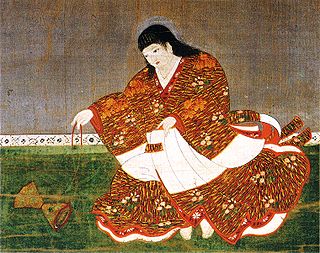 W
WEmperor Antoku was the 81st emperor of Japan, according to the traditional order of succession. His reign spanned the years from 1180 through 1185.
 W
WSaitō Musashibō Benkei , popularly known as simply Benkei, was a Japanese warrior monk (sōhei) who lived in the latter years of the Heian Period (794–1185)[1]. Benkei led a varied life, first becoming a monk, then a mountain ascetic, and then a rogue warrior. He later came to respect and serve the famous warrior Minamoto no Yoshitsune, also known as Ushiwakamaru. He is commonly depicted as a man of great strength and loyalty, and a popular subject of Japanese folklore, showcased in many ancient and modern literature and productions.
 W
WChōgen (重源) (1121-1206), also known as Shunjōbō Chōgen (俊乗坊重源), was a Japanese Buddhist monk. From 1181 he devoted twenty-five years of his life to the endowment and rebuilding of Tōdai-ji after its destruction in war.
 W
WEmperor Daigo was the 60th emperor of Japan, according to the traditional order of succession.
 W
WDōin was a Japanese waka poet of the late-Heian period. One of his poems was included in the Ogura Hyakunin Isshu, and forty-one of his poems were included in imperial collections.
 W
WEgaku or Hui'E was a well-connected 9th century Japanese scholar-monk who made frequent trips to Tang China for pilgrimage and bringing back Buddhist teachings to Japan. Egaku had a huge impact on the religious and cultural history of China and Japan. In Japan, he is famous for bringing the first Rinzai Zen monk Gikū and the works of the Chinese poet Bai Juyi to Japan. In China, he is renowned for his role in establishing a developed pilgrimage site in Putuoshan, one of the four major Buddhist pilgrimage sites in China.
 W
WEgyō was a Japanese waka poet of the mid-Heian period. One of his poems was included in the Ogura Hyakunin Isshu. He produced a private collection, the Egyō-hōshi-shū, and was listed as one of the Late Classical Thirty-Six Immortals of Poetry.
 W
WMyōan Eisai/Yōsai was a Japanese Buddhist priest, credited with founding the Japanese line of the Rinzai school of Zen Buddhism. In 1191, he introduced this doctrine to Japan, following his trip to China from 1187 to 1191, during which he was initiated into the Linji school by the master Hsü an. It is also said that he popularized green tea in Japan, following this same trip. He was also the founding abbot of Japan's first Zen temple Shōfuku-ji and Kennin-ji. He is often known simply as Eisai/Yōsai Zenji (栄西禅師), literally "Zen master Eisai".
 W
WEnchin (円珍) (814–891) was a Japanese Buddhist monk who founded of the Jimon school of Tendai Buddhism and Chief Abbot of Mii-dera at the foot of Mount Hiei. After succeeding to the post of Tendai zasu , in 873, a strong rivalry developed between his followers and those of Ennin's at Enryaku-ji.
 W
WEnnin , better known in Japan by his posthumous name, Jikaku Daishi (慈覺大師), was a priest of the Tendai school of Buddhism in Japan, and its third Zasu . Ennin was instrumental in expanding the Tendai Order's influence, and bringing back crucial training and resources from China particularly esoteric Buddhist training, and Pure Land teachings.
 W
WFujiwara no Moronaga was a Japanese politician, noble and musician during the Heian era. He was also known as Myo-On-In Daishokoku.
 W
WFujiwara no Michinaga was a Japanese statesman. The Fujiwara clan's control over Japan and its politics reached its zenith under his leadership.
 W
WFujiwara no Morosuke , also known as Kujō-dono or Bōjō-udaijin, was a Japanese statesman, courtier and politician during the middle Heian period. Considered a learned scholar and well-versed in the customs of the court, he supported the court's government as udaijin during the reign of Emperor Murakami. Morosuke's eldest daughter Fujiwara no Anshi, empress consort to Emperor Murakami, gave birth to two princes who later became Emperor Reizei and Emperor En'yū, putting Morosuke's lineage in an advantageous position as the maternal relatives of the Emperor.
 W
WFujiwara no Tadaie , also known as Mikohidari Tadaie, was a Japanese statesman, courtier, politician, poet and calligrapher during the Heian period.
 W
WFujiwara no Yorimichi (992–1071), son of Michinaga, was a Japanese Court noble. He succeeded his father to the position of Sesshō in 1017, and then went on to become Kampaku from 1020 until 1068. In both these positions, he acted as Regent to the Emperor, as many of his ancestors and descendants did; the Fujiwara clan had nearly exclusive control over the regency positions for over 200 years. Prior to succeeding to the position of Regent, Yorimichi had held the title of Naidaijin, the lowest level of state ministers. By edict, he was raised above his colleagues, to the title of Ichi no Hito, or First Subject. In addition to the reason of direct succession from his father, this edict was presumably necessary to allow Yorimichi to become Sesshō.
 W
WGenshin , also known as Eshin Sōzu (恵心僧都), was the most influential of a number of scholar-monks of the Buddhist Tendai sect active during the tenth and eleventh centuries in Japan. Genshin, who was trained in both esoteric and exoteric teachings, wrote a number of treatises pertaining to the increasingly popular Pure Land Buddhism from a Tendai viewpoint, but his magnum opus, the Ōjōyōshū had considerable influence on later Pure Land teachers such as Honen and Shinran. In spite of growing political tensions within the Tendai religious hierarchy, and despite being one of the two leading disciples of the controversial Ryogen, 18th head of the Enryakuji Temple, Genshin and a small group of fellow monks maintained a secluded community at Yokawa on Mount Hiei solely devoted toward rebirth in the Pure Land, while staying largely neutral in the conflict. He was one of the thinkers who maintained that the nembutsu ritual, which was said to induce a vision of Amida, was an important hermeneutic principle in the Buddhist doctrinal system.
 W
WGikū or Yikong was an early Heian period Buddhist monk from Tang China. He is Japan's first Buddhist monk who exclusively taught Zen.
 W
WEmperor Go-Sanjō was the 71st emperor of Japan, according to the traditional order of succession.
 W
WEmperor Go-Shirakawa was the 77th emperor of Japan, according to the traditional order of succession. His de jure reign spanned the years from 1155 through 1158, though arguably he effectively maintained imperial power for almost thirty-seven years through the insei system – scholars differ as to whether his rule can be truly considered part of the insei system, given that the Hōgen Rebellion undermined the imperial position. However, it is broadly acknowledged that by politically outmaneuvering his opponents, he attained greater influence and power than the diminished authority of the emperor's position during this period would otherwise allow.
 W
WGyōson , also known as the Abbot of Byōdō-in , was a Japanese Tendai monk and waka poet of the late-Heian period. He became chief prelate of the Enryaku-ji temple in Kyoto, and one of his poems was included in the Ogura Hyakunin Isshu. Almost fifty of his poems were included in imperial anthologies, and he produced a private collection of poetry.
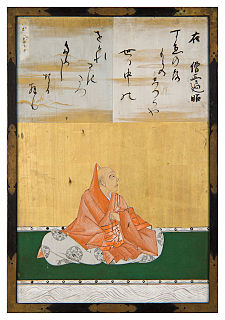 W
WYoshimine no Munesada (良岑宗貞), better known as Henjō , was Japanese waka poet and Buddhist priest. In the poetry anthology Kokin Wakashū, he is listed as one of the six notable waka poets and one of the thirty-six immortals of poetry.
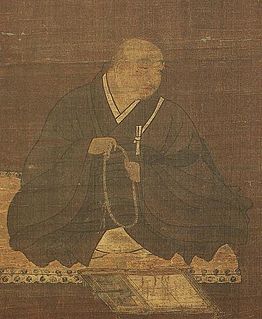 W
WHōnen was the religious reformer and founder of the first independent branch of Japanese Pure Land Buddhism called Jōdo-shū . He is also considered the Seventh Jōdo Shinshū Patriarch.
 W
WEmperor Ichijō was the 66th emperor of Japan, according to the traditional order of succession.
 W
WJakuren (寂蓮) (1139–1202) was a Japanese Buddhist priest and poet. He was adopted by the noted poet Fujiwara no Shunzei upon the death of Shunzei's younger brother. Shunzei originally intended for Sadanaga to be his heir; however, he subsequently had two male offspring of his own, and Sadanaga was forced to step aside in favor of Fujiwara no Sadaie. As was common practice at the time, he became a monk, and acquired the religious name of Jakuren. Taking Saigyo as his model, he traveled around the country, composing poems of his travels. He was well regarded in his time and frequently associated with Fujiwara no Teika. He was one of the six compilers of the eighth imperial waka anthology, the famous Shin Kokin Wakashū, and thirty-five of his poems were selected for the work. Before he died, he adopted Fujiwara no Ietaka, pupil to Shunzei. One of his poems was included in the famous poetry anthology Hyakunin Isshu.
 W
WJien was a Japanese poet, historian, and Buddhist monk.
 W
WEmperor Kazan was the 65th emperor of Japan, according to the traditional order of succession.
 W
WKisen (喜撰) was an early Heian period Buddhist monk and waka poet. Little is known about his life other than that he lived in Mount Uji.
 W
WKakuban, known posthumously as Kōgyō-Daishi (興教大師) was a priest of the Shingon sect of Buddhism in Japan and credited as a reformer, though his efforts also led to a schism between Kogi Shingon-shū and Shingi Shingon-shū . Kakuban is also famous for his introduction of the "esoteric nembutsu".
 W
WKūkai, also known posthumously as Kōbō Daishi , was a Japanese Buddhist monk, calligrapher, and poet who founded the esoteric Shingon school of Buddhism. He travelled to China, where he studied Tangmi under the monk Huiguo. Upon returning to Japan, he founded Shingon—the Japanese branch of Vajrayana Buddhism. With the blessing of several Emperors, Kūkai was able to preach Shingon teachings and found Shingon temples. Like other influential monks, Kūkai oversaw public works and constructions. Mount Kōya was chosen by him as a holy site, and he spent his later years there until his death in 835 C.E.
 W
WKūya was an itinerant Japanese Buddhist monk, or hijiri (聖), later ordained in the Tendai Buddhist sect, who was an early proselytizer of the practice of the nembutsu amongst the populace. Kuya's efforts helped promote the Pure Land teaching of Buddhism to the capital at a time when the movement was first gaining traction in Japan. For his efforts, Kuya earned the name ichi hijiri and Amida hijiri. Kūya was known for taking images with him on his travels and added musical rhythm and dance to his prayers, known as odori nembutsu. Like Gyōki, he is said to have performed works for the public benefit such as building roads and bridges, digging wells, and burying abandoned corpses.
 W
WFujiwara no Motofusa was an imperial regent in the late 12th century, serving both Emperor Rokujō and Emperor Takakura. He was also called Matsudono Motofusa , as he came from the village of Matsudono, near Kyoto. Fujiwara no Tadataka and Matsudono Moroie were his first and third sons, respectively.
 W
WMinamoto no Mitsunaka , was born as Myoomaru (明王丸) son of Minamoto no Tsunemoto, was a samurai and Court official of Japan's Heian period. Mitsunaka belonged to the Seiwa Genji branch of the Minamoto clan, which traced its ancestry to Emperor Seiwa. He loyally served several successive Fujiwara regents beginning with Fujiwara no Morotada. There is debate among scholars as to his involvement in the Anna Plot of 969. All agree that Mitsunaka alleged that Minamoto no Takaakira was plotting against the Throne. However, whilst some believe that there was a genuine threat to the Throne, and that it was Mitsunaka's warning that prevented the plot from succeeding, others view the incident as one manufactured for political gain. Takaakira was Morotada's principal rival, and his being implicated in the plot removed him as a threat; the truthfulness of the accusations levelled against Takaakira is not known. In any case, the negative consequences for Takaakira put Mitsunaka firmly in Morotada's good graces. Later, Mitsunaka would assist Fujiwara no Kaneie in his plot to coerce Emperor Kazan into taking Buddhist vows and abdicating in favor of Fujiwara's seven-year-old grandson.
 W
WMinamoto no Yorimasa was a prominent Japanese poet whose works appeared in various anthologies. He served eight different emperors in his long career, holding posts such as hyōgo no kami. He was also a warrior, leading the Minamoto armies at the beginning of the Genpei War.
 W
WMinamoto no Yoriyoshi was a head of Japan's Minamoto clan. Along with his son Minamoto no Yoshiie, he led the Imperial forces against rebellious forces in the north. This campaign would be called the Zenkunen War, and would be followed some years later by the Gosannen War. His childhood name was Odaimaru (王代丸).
 W
WTachibana no Nagayasu , also known was Nōin , was a Japanese poet and monk of the late Heian period.
 W
WDainichibō Nōnin (大日房能忍) was a Japanese Buddhist monk who started the first Zen school in Japan.
 W
WRyōgen was the 18th chief abbot of Enryaku-ji in the 10th century.
 W
WRyōzen was a Japanese waka poet of the mid-Heian period. One of his poems was included in the Ogura Hyakunin Isshu, and thirty-one of his poems were included in imperial anthologies from the Goshūi Wakashū on.
 W
WSaichō was a Japanese Buddhist monk credited with founding the Tendai school of Buddhism based on the Chinese Tiantai school he was exposed to during his trip to Tang China beginning in 804. He founded the temple and headquarters of Tendai at Enryaku-ji on Mount Hiei near Kyoto. He is also said to have been the first to bring tea to Japan. After his death, he was awarded the posthumous title of Dengyō Daishi (伝教大師).
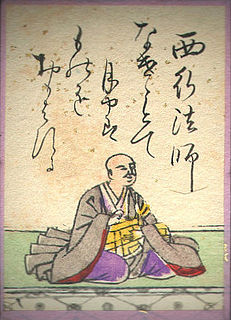 W
WSaigyō Hōshi was a famous Japanese poet of the late Heian and early Kamakura period.
 W
WEmperor Sanjō was the 67th emperor of Japan, according to the traditional order of succession.
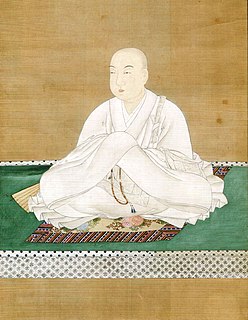 W
WEmperor Seiwa was the 56th emperor of Japan, according to the traditional order of succession.
 W
WEmperor Shirakawa was the 72nd emperor of Japan, according to the traditional order of succession.
 W
WShōkū , sometimes called Seizan (西山), was a disciple of Hōnen, founder of the Jōdo-shū Buddhist sect. Shōkū later succeeded Jōhen, another disciple of Hōnen, as the head of a former Shingon Buddhist temple, Eikandō, established a separate branch of Jōdo-shū called the Seizan branch, and completed the transition of Eikandō from a Shingon temple into a Jōdo shū one.
 W
WShun'e , also known as Tayū no Kimi (大夫公), was a Japanese waka poet of the late-Heian period. One of his poems was included in the Ogura Hyakunin Isshu. He produced a private collection, the Rin'yō Wakashū, and was listed as one of the Late Classical Thirty-Six Immortals of Poetry.
 W
WSosei was a Japanese waka poet and Buddhist priest. He is listed as one of the Thirty-six Poetry Immortals, and one of his poems was included in the famous anthology Hyakunin Isshu. His father Henjō was also a waka poet and monk.
 W
WTaira no Kiyomori was a military leader and kugyō of the late Heian period of Japan. He established the first samurai-dominated administrative government in the history of Japan.
 W
WTaira no Shigemori was the eldest son of the Taira clan patriarch, Taira no Kiyomori. He supported his father in the Heiji Rebellion. He died two years before his father. His son, Taira no Koremori, became a monk in 1184, and drowned himself. Oda Nobunaga claimed to have descended from him through his grandson, Taira no Chikazane.
 W
WEmperor Toba was the 74th Emperor of Japan, according to the traditional order of succession.
 W
WPrince Tsunesada was a Japanese prince of the early Heian period. He was the second son of Emperor Junna. He was also known as Prince Teishi (亭子親王), and by his Buddhist name of Gōjyaku (恒寂). He was Crown Prince from 833 to 842, during the reign of his cousin Emperor Ninmyō.
 W
WEmperor Uda was the 59th emperor of Japan, according to the traditional order of succession.